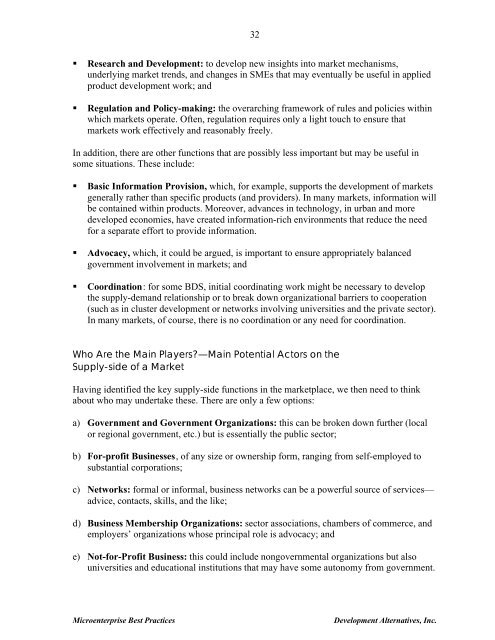BDS market development guide.pdf - PACA
BDS market development guide.pdf - PACA
BDS market development guide.pdf - PACA
Create successful ePaper yourself
Turn your PDF publications into a flip-book with our unique Google optimized e-Paper software.
32<br />
• Research and Development: to develop new insights into <strong>market</strong> mechanisms,<br />
underlying <strong>market</strong> trends, and changes in SMEs that may eventually be useful in applied<br />
product <strong>development</strong> work; and<br />
• Regulation and Policy-making: the overarching framework of rules and policies within<br />
which <strong>market</strong>s operate. Often, regulation requires only a light touch to ensure that<br />
<strong>market</strong>s work effectively and reasonably freely.<br />
In addition, there are other functions that are possibly less important but may be useful in<br />
some situations. These include:<br />
• Basic Information Provision, which, for example, supports the <strong>development</strong> of <strong>market</strong>s<br />
generally rather than specific products (and providers). In many <strong>market</strong>s, information will<br />
be contained within products. Moreover, advances in technology, in urban and more<br />
developed economies, have created information-rich environments that reduce the need<br />
for a separate effort to provide information.<br />
• Advocacy, which, it could be argued, is important to ensure appropriately balanced<br />
government involvement in <strong>market</strong>s; and<br />
• Coordination: for some <strong>BDS</strong>, initial coordinating work might be necessary to develop<br />
the supply-demand relationship or to break down organizational barriers to cooperation<br />
(such as in cluster <strong>development</strong> or networks involving universities and the private sector).<br />
In many <strong>market</strong>s, of course, there is no coordination or any need for coordination.<br />
Who Are the Main Players?—Main Potential Actors on the<br />
Supply-side of a Market<br />
Having identified the key supply-side functions in the <strong>market</strong>place, we then need to think<br />
about who may undertake these. There are only a few options:<br />
a) Government and Government Organizations: this can be broken down further (local<br />
or regional government, etc.) but is essentially the public sector;<br />
b) For-profit Businesses, of any size or ownership form, ranging from self-employed to<br />
substantial corporations;<br />
c) Networks: formal or informal, business networks can be a powerful source of services—<br />
advice, contacts, skills, and the like;<br />
d) Business Membership Organizations: sector associations, chambers of commerce, and<br />
employers’ organizations whose principal role is advocacy; and<br />
e) Not-for-Profit Business: this could include nongovernmental organizations but also<br />
universities and educational institutions that may have some autonomy from government.<br />
Microenterprise Best Practices<br />
Development Alternatives, Inc.














